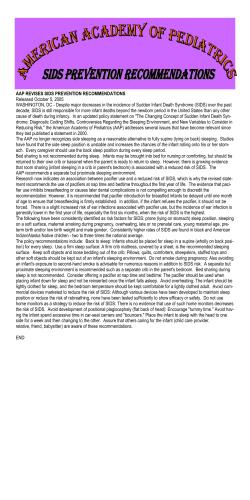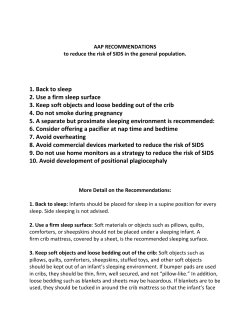
I n f a
PREGNANCY RISK ASSESSMENT MONITORING SYSTEM A survey for healthier babies in New Jersey Infant Sleep Position and SIDS Risk Factors The American Academy of Pediatrics (AAP) advises that placing infants to sleep on their backs (supine) reduces the risk of Sudden Infant Death Syndrome (SIDS), the leading cause of infant mortality from one month to one year of age. New Jersey’s rate of SIDS is about 40% lower than the national rate. Black infants experience five times the risk, and Hispanics twice the risk, of white infants. Prior to 1992, only 13% of infants in the United States were placed to sleep on their backs. Since the AAP recommendation and the resulting Back to Sleep campaign, supine infant sleep has risen, and the rate of SIDS declined by 56% nationwide. How are New Jersey mothers responding to the Back to Sleep message? According to the NJ-PRAMS survey, from 2002 through 2005 60% of New Jersey mothers most often put their infants down on their backs. An additional 4% reported a mixture of side and back postures, which is not recommended by AAP. Adherence to Back to Sleep is not uniform across all social groups. About 70% of white and Asian mothers used the back position predominantly, thus meeting the Healthy People 2010 goal. In contrast, only 40% of black mothers and 47% of Hispanic mothers report doing so. Black mothers were twice as likely as other groups to report prone as the most frequent position (25%). Tobacco smoke exposure is another known risk factor for SIDS. Smoking by anyone in the house is most prevalent for black mothers. However, post-partum NJ-PRAMS is a joint project of the New Jersey Department of Health and Senior Services and the Centers for Disease Control and Prevention (CDC). Information from PRAMS is used to help plan better health programs for New Jersey mothers and infants—such as improving access to high quality prenatal care, reducing smoking, and encouraging breastfeeding. ▫ One out of every 38 mothers are sampled each month, when newborns are 2-6 months old. Survey questions address their feelings and experiences before, during and after their pregnancy. ▫ From 2002 to 2005, 7,661 mothers were interviewed with a 72% response rate. Data for 2005 is preliminary. smoking by the mother is about equal for black and white mothers. By either measure, smoke exposure is much less prevalent for infants whose mothers have at least some college education. Since 2000, bed sharing during sleep was defined by the AAP as a risk factor under certain conditions; in its 2005 policy revisions, the AAP strengthened its advice that infants not bed share during sleep. In PRAMS, bed sharing (Q: How often does your baby sleep in the same bad with you or anyone else? A: always, often) is reported among all groups, but especially among black and less-than-college-educated women (see next page). The AAP strongly endorses the diverse benefits of breastfeeding, and the new SIDS guidelines explicitly address implementation when parents prefer to breastfeed. Smoking prevalence, percent Most frequent sleep position, percent 0% 10% 20% 30% 40% 50% 60% 60% Asian, not Hispanic less than high school 41% high school graduate 51% 68% 15% 20% 25% black, not Hispanic Hispanic 69% 10% white, not Hispanic On back On back & side 47% 80% 5% All 70% 40% 70% 0% college Smoking in house Mom smokes now 30% Agenda for Action A large proportion of New Jersey’s most socially advantaged mothers have absorbed the Back to Sleep message and other information about SIDS risk factors, but others have not. Culturally competent outreach and education through primary health care providers, child care facilities, and public health programs serve as the vehicles for penetrating all social groups and overcoming barriers to awareness. The Resources below provide guidance regarding interventions and overcoming potential barriers. 9 Parent education should begin before birth and continue throughout the postpartum stay and beyond. Parents are more responsive when they see supine sleep and a safe sleep environment demonstrated in the hospital and when the advice is reinforced by their providers. 9 Remind parents that infants placed supine are not at increased risk for aspiration so that this concern does not become a barrier to compliance 9 Infants should have “tummy time” when awake and under supervision. This reduces the risk of flat spots on the occiput and promotes motor milestones for head control. 9 Parents should inform all care givers, including family members, about Back to Sleep. Unaccustomed prone sleep carries the greatest risk for SIDS. 9 Premature infants, at higher risk for SIDS, can be safely placed supine for sleep. SIDS risk reduction education for all parents of NICU infants must commence before discharge. 9 Eliminate all tobacco smoke exposure in the home, car, or when visiting. 9 Create a safe sleep environment: avoid overheating, pillows, soft sleep surfaces such as quilts or sheepskins and loose bedding that might accidentally cover the infant’s face. 9 Infants should not bed share during sleep. A separate but nearby sleeping surface is recommended, such as a bassinet next to the parent’s bed. Infants may be brought into the parent’s bed for feeding and comforting, but then returned for separate sleep. 9 Consider offering a pacifier when placing an infant to sleep. If breastfeeding, wait about one month, or until nursing is well-established. Do not reinsert if it falls out during sleep; do not force the infant to take it; clean and replace frequently; do not coat with any sweet solution. 9 Avoid commercial devices marketed to reduce the risk of SIDS as none has been tested sufficiently to show efficacy or safety. Contact NJ-PRAMS www.nj.gov/health/fhs/professional/prams.shtml Lakota K. Kruse, MD MPH, Project Director. Document authored March 2007 by Barbara M. Ostfeld, PhD and Thomas Hegyi, MD (UMDNJ-Robert Wood Johnson Medical School and SIDS Center of New Jersey) and Charles E. Denk, PhD (NJ-PRAMS staff). Prevalence, percent 0% 20% 40% 60% 80% All white, not Hispanic black, not Hispanic Hispanic Asian, not Hispanic less than high school high school graduate college Baby sleeps with others Breastfeeding at ten weeks Resources Sudden Infant Death Syndrome Center of New Jersey (SCNJ), NJDHSS program at the University of Medicine and Dentistry of New Jersey-Robert Wood Johnson Medical School and Hackensack University Medical Center: 800.545.7437 www2.umdnj.edu/sids/ National Institute of Child Health and Human Development. Distributes the Back to Sleep educational materials without charge in English and Spanish. 800.505.CRIB www.nichd.nih.gov/sids/ American Academy of Pediatrics, Task Force on SIDS. The changing concept of sudden infant death syndrome: Diagnostic coding shifts, controversies regarding the sleeping environment, and new variables to consider in reducing risk. Pediatrics. 2005;116:1245-55. Free at: www.healthychildcare.org/revised%20SIDS.pdf AWHONN summarizes the American Academy of Pediatrics' revised SIDS prevention recommendations and highlights issues raised. www.awhonn.org/awhonn/?pg=873-8010-18770 National SIDS/Infant Death Program Support Center. Provides sample policies, procedures and training materials for NICU and well baby nurseries. www.sidscenter.org/TrainingMaterials.aspx?fromparent=p arent&id=5&heading=TrainingMaterials
© Copyright 2026





















